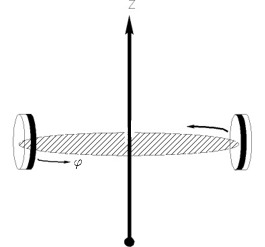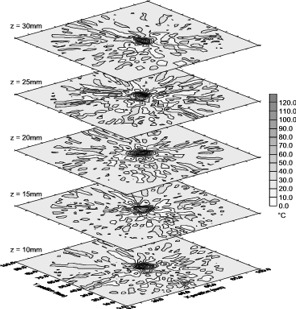home
> products
> BAT's
>
BAT
examples
> example A.2.b
Tomographic imaging of temperature-fields in gases using air-coupled BAT® transducers
The experiment:
This example shows how MicroAcoustic's
BAT®
transducers can be used to non-invasively image temperature fields in gases
 by
tomographic techniques. Two BAT-1
transducers are set up to be facing each other in a common plane at height
z, as shown in the figure at right. Pulsed ultrasonic
waves are launched by one transducer and received by the other while
moving and rotating the transducers about so as to fill the
hash-marked plane with a
large number of ultrasonic rays (i.e., like the spokes of a wheel). From
the received waveforms recorded for all ray-paths, tomographic
reconstruction algorithms are then used to reconstruct an image of the
ultrasonic properties of the gaseous medium within the plane (including
any variations that may be present therein). As variations can occur due
to the presence of pressure-, temperature- and flow- fields, for example,
or due to the presence of solid and liquid inclusions, ultrasonic images
of such variations can be obtained. The fact that the BAT®
sensors do not have to be inserted into the region of interest makes
the measurement non-invasive and
thus limits
any distortion of the
temperature-field
(or other variation) that you're
actually trying to measure.
by
tomographic techniques. Two BAT-1
transducers are set up to be facing each other in a common plane at height
z, as shown in the figure at right. Pulsed ultrasonic
waves are launched by one transducer and received by the other while
moving and rotating the transducers about so as to fill the
hash-marked plane with a
large number of ultrasonic rays (i.e., like the spokes of a wheel). From
the received waveforms recorded for all ray-paths, tomographic
reconstruction algorithms are then used to reconstruct an image of the
ultrasonic properties of the gaseous medium within the plane (including
any variations that may be present therein). As variations can occur due
to the presence of pressure-, temperature- and flow- fields, for example,
or due to the presence of solid and liquid inclusions, ultrasonic images
of such variations can be obtained. The fact that the BAT®
sensors do not have to be inserted into the region of interest makes
the measurement non-invasive and
thus limits
any distortion of the
temperature-field
(or other variation) that you're
actually trying to measure.
Images of a flow-field:
 In
this example, the above experimental arrangement was used to obtain images
of a temperature field created above a specially modified soldering iron. In particular, air-coupled
ultrasonic tomographic images were obtained at 5 different heights above
the tip of the soldering iron, and the results are shown in the
figure at right for z = 10mm, 15mm, 20mm, 25mm and 30mm. The
variable used for tomographic reconstruction in these images was the
effective local ultrasound velocity within the tomographic planes. And, as
the local ultrasound velocity was affected by the local temperature of the
gas, the images end up displaying the temperature variations that exist
above the tip of the soldering iron in units of °C. As the soldering iron
had been fitted with a ceramic coaxial sheath it created a narrow beam of
rising heated air, which was properly imaged by the tomographic system as
the central black non-expanding region within the images. The
reconstruction algorithms employed allowed the
measured ultrasound velocity (due to heating) to be converted
into local gas temperature with an accuracy of approximately ±2°C.
Improvements in the accuracy of temperature measurements by this approach
are thought to be possible in the future.
In
this example, the above experimental arrangement was used to obtain images
of a temperature field created above a specially modified soldering iron. In particular, air-coupled
ultrasonic tomographic images were obtained at 5 different heights above
the tip of the soldering iron, and the results are shown in the
figure at right for z = 10mm, 15mm, 20mm, 25mm and 30mm. The
variable used for tomographic reconstruction in these images was the
effective local ultrasound velocity within the tomographic planes. And, as
the local ultrasound velocity was affected by the local temperature of the
gas, the images end up displaying the temperature variations that exist
above the tip of the soldering iron in units of °C. As the soldering iron
had been fitted with a ceramic coaxial sheath it created a narrow beam of
rising heated air, which was properly imaged by the tomographic system as
the central black non-expanding region within the images. The
reconstruction algorithms employed allowed the
measured ultrasound velocity (due to heating) to be converted
into local gas temperature with an accuracy of approximately ±2°C.
Improvements in the accuracy of temperature measurements by this approach
are thought to be possible in the future.
1) This example shows that MicroAcoustic's BAT® transducers can be use for non-invasive imaging of temperature fields in gases using tomographic reconstruction techniques.
2) Because BAT® transducers do not need to be placed within the temperature field itself, images obtained in this way are not distorted by the presence of the sensors as occurs with other more-invasive temperature sensors.
<< previous example ~ next example >>
www.microacoustic.com